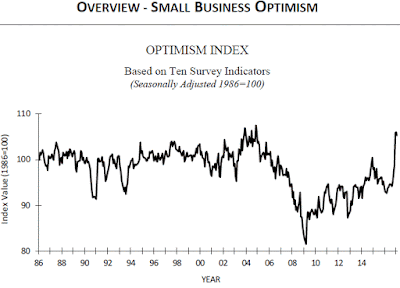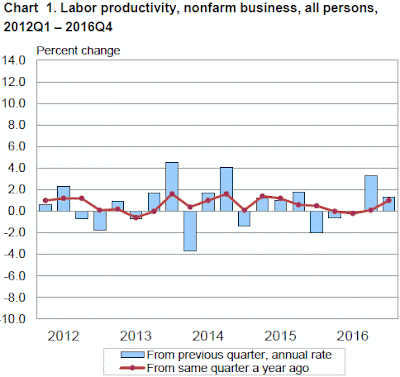Consumer Sentiment: Final Result for March 2017
Predicted: 97.6
Actual: 96.9
- Change from Last Month: +0.623%
- Change from 12 Months Ago: +6.484%
=========
From today's report:
"...The continued strength in consumer sentiment has been due to optimistic views on three critical components: higher incomes and wealth, more favorable job prospects, and low inflation expectations. All of these factors, however, have been influenced by partisanship. Democrats expect an imminent recession, higher unemployment, lower income gains, and more rapid inflation, while Republicans anticipate a new era of robust growth in incomes, job prospects, and lower inflation. It is a rare situation that combines increasing optimism, which promotes spending, and rising uncertainty which makes consumers more cautious spenders. The high prevailing level of sentiment reflects the use of changed evaluative criteria. Like economists who have lowered growth prospects, consumers have done the same, and have thus judged lower rates of growth more favorably than they would have in an earlier era. While the partisan divide will likely recede in the months ahead, consumers’ new evaluative standards will resist change. In an earlier era, growth of 3.0% was below average and a cause for concern, now growth above 2.5% represents an optimistic outlook. Overall, the data indicate both rising optimism as well as rising uncertainty due to the partisan divide. The data indicate that real consumer spending will advance by 2.7% in 2017, but those gains will be uneven over time and across products..."
=========
The ICS is derived from the following five survey questions:
- "We are interested in how people are getting along financially these days. Would you say that you (and your family living there) are better off or worse off financially than you were a year ago?"
- "Now looking ahead, do you think that a year from now you (and your family living there) will be better off financially, or worse off, or just about the same as now?"
- "Now turning to business conditions in the country as a whole, do you think that during the next twelve months we'll have good times financially, or bad times, or what?"
- "Looking ahead, which would you say is more likely: that in the country as a whole we'll have continuous good times during the next five years or so, or that we will have periods of widespread unemployment or depression, or what?"
- "About the big things people buy for their homes, such as furniture, a refrigerator, stove, television, and things like that. Generally speaking, do you think now is a good or bad time for people to buy major household items?"
- Click here for more on how the ICS is calculated.
=========
The ICS uses a 1966 baseline, i.e. for 1966, the ICS = 100. So any number that is below the 1966 baseline of 100 means that the folks who were polled recently aren't as optimistic about the U.S. economy as the sample that was polled back in 1966.
The ICS is similar to the Consumer Confidence Index in that they both measure consumer attitudes and offer valuable insight into consumer spending.
=========
The "predicted" figure is what economists were expecting, while the "actual" is the true or real figure.
=========
Last month's final ICS reading was 96.3.
Labels: consumer_sentiment
|
--> www.FedPrimeRate.com Privacy Policy <--
CLICK HERE to JUMP to the TOP of THIS PAGE > SITEMAP < |









